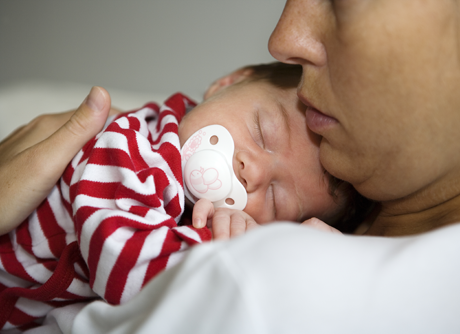The brains of newborns distinguish between caresses

The ability to distinguish between different kinds of caresses on the skin already exists at a very early age. This is evident from a study by the Sahlgrenska Academy, in which the blood supply in brains of infants 6 to 10 weeks old was investigated.
"This type of neuroimaging study has not been done on such young children before, and it also is the first time that measurements have been made so deep in the brain with this particular technology," says Emma Jönsson, a doctoral student at the Institute of Neuroscience and Physiology with a master of science in engineering degree in biotechnology.
The study, which is part of her thesis, encompasses 16 infants with an average age of eight weeks. For 30 to 40 minutes, they were subjected to tactile stimulation of the skin on their arms with soft brush strokes at different velocities. All rested securely in their mothers' arms, awake or sleeping, and were fitted with elastic bandages around the head that held the measuring equipment in place.
The equipment recorded blood flow in the brain. A greater supply of blood to certain areas of the brain indicates that these areas are helping to process the stimuli being perceived, in this case the soft brush strokes.
The children's arms were caressed at two different velocities, one relatively fast (20 centimeters per second) and one slower (3 centimeters per second). The slower velocity is in the range that people typically use for caressing other people and therefore is considered more social and affective than the fast velocity. And it turned out that the slow strokes produced a much stronger reaction in the brain than the fast ones.
"What we have found is that the newborn brain already has another way of processing the more social touch, if it is compared with the less social one," Emma Jönsson says. "It indicates that this is a priority from a very early age, and that touch is very important in infancy. Previous studies also have shown the importance of touch, but this is the first time that we can see it purely in terms of brain activation.
"Different parts of the nervous system mature at different rates, but human communication takes place at such a fundamental level," she continues, "and it is important for even small children to be able to perceive it. Our brain is prepared to process this from birth. Touch is important for early bond formation with parents, and it is necessary for normal development.
There are several difficulties involved in investigating very small children. They cannot be asked about how they experience touch, whereas in studies of adults the subjects' own perceptions also are taken into account. And other neuroimaging methods have required that the head be kept stationary, which is difficult when it comes to infants. The current method and equipment, which uses near-infrared light to measure blood flows, allows the child to move to some extent. The study was carried out in Turku with colleagues from Finland, Sweden and Germany.
Her thesis also includes other studies of interpersonal affective touch, although they involved adults. Among other things, research shows that a person in a longstanding relationship is less inclined to experience a touch as erotic and that the feeling of pleasure when touched is stronger among women than among men. The studies constitute new building blocks within an area of research that, according to Emma Jönsson, will continue to grow.
"Touch has been studied a great deal less than hearing and sight, but just during the few years I've been working with it, the field has grown much larger," she declares.
More information: Affective touch throughout life: from cortical processing in infancy to touch perception in adulthood: hdl.handle.net/2077/51879



















